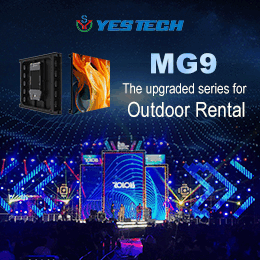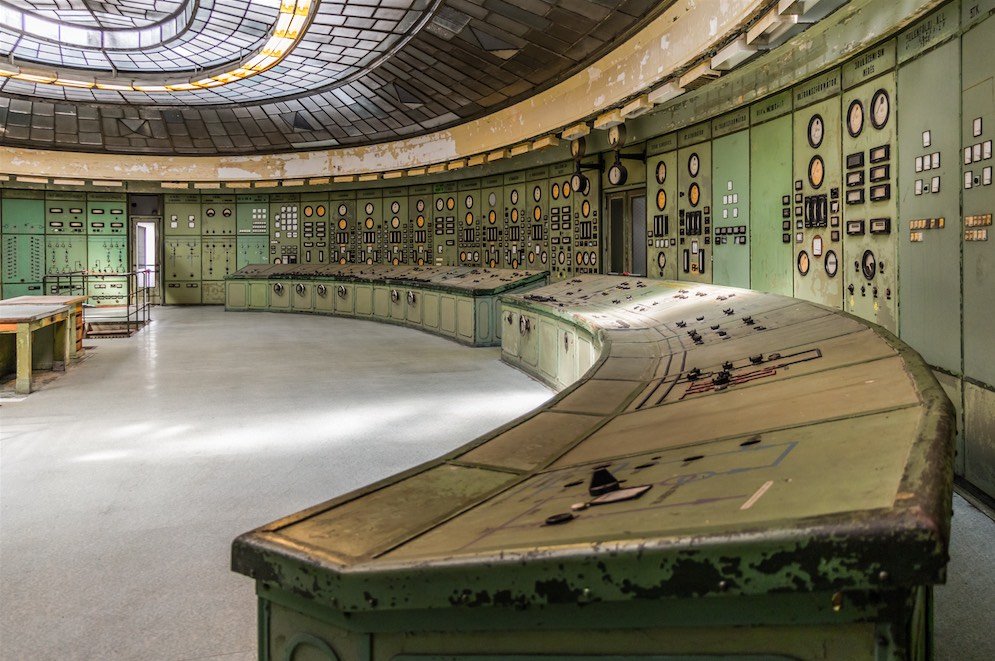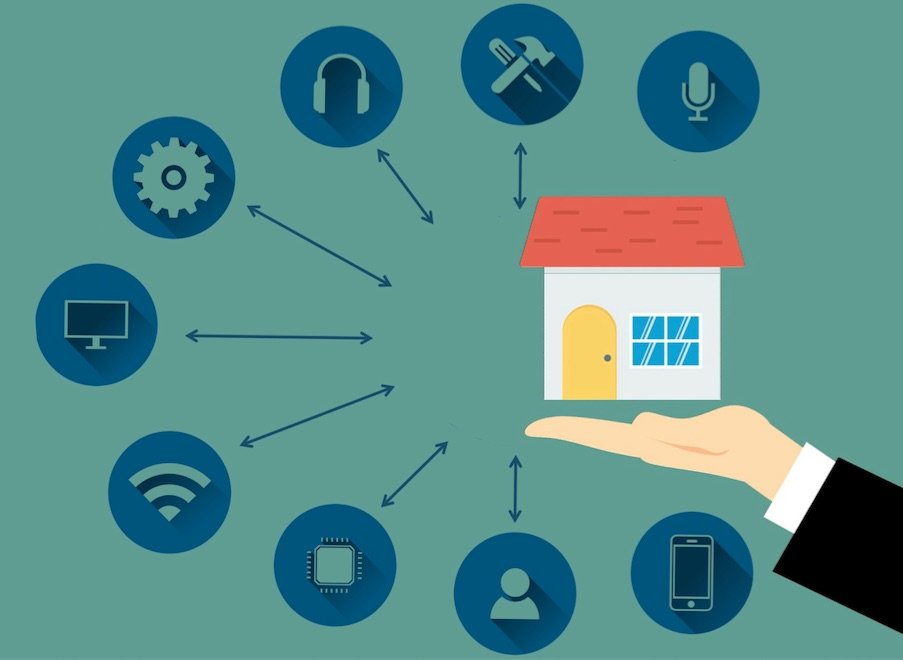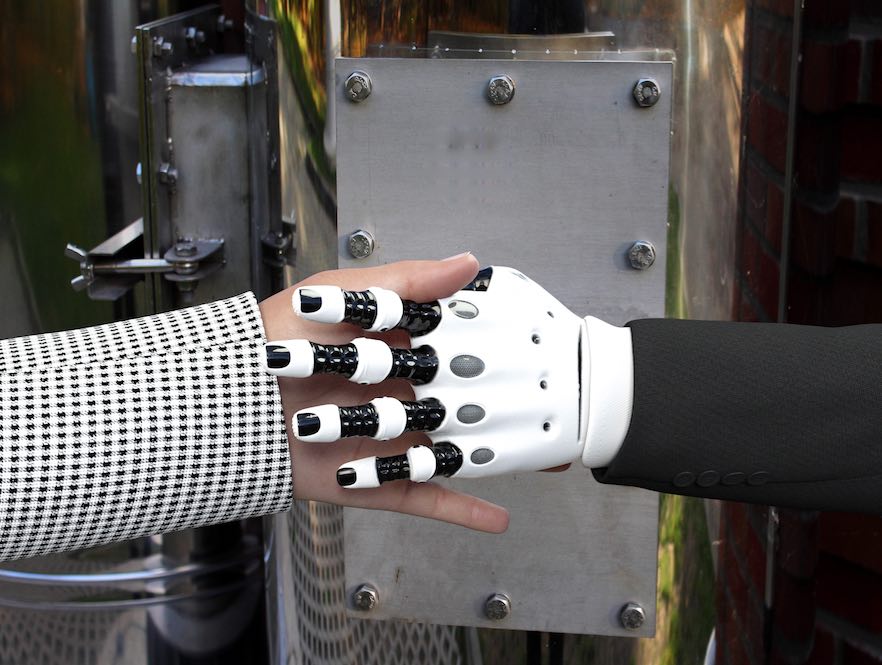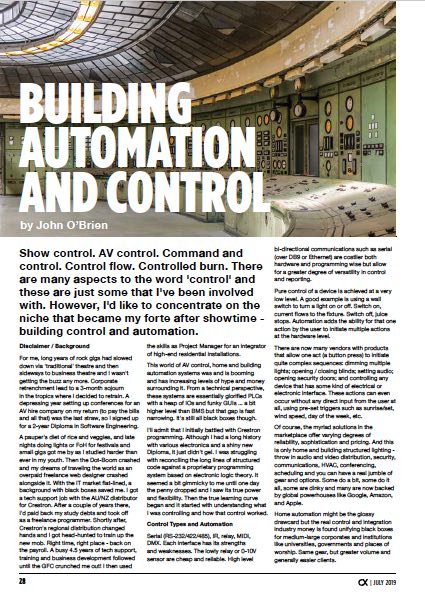Subscribe to CX E-News
CONTROL
Building Automation and Control
by John O’Brien.
Show control. AV control. Command and control. Control flow. Controlled burn. There are many aspects to the word ‘control’ and these are just some that I’ve been involved with. However, I’d like to concentrate on the niche that became my forte after showtime – building control and automation.
Disclaimer / Background
For me, long years of rock gigs had slowed down via ‘traditional’ theatre and then sideways to business theatre and I wasn’t getting the buzz any more. Corporate retrenchment lead to a 3-month sojourn in the tropics where I decided to retrain. A depressing year setting up conferences for an AV hire company on my return (to pay the bills and all that) was the last straw, so I signed up for a 2-year Diploma in Software Engineering.
A pauper’s diet of rice and veggies, and late nights doing lights or FoH for festivals and small gigs got me by as I studied harder than ever in my youth. Then the Dot-Boom crashed and my dreams of traveling the world as an overpaid freelance web designer crashed alongside it.
With the IT market flat-lined, a background with black boxes saved me. I got a tech support job with the AU/NZ distributor for Crestron. After a couple of years there, I’d paid back my study debts and took off as a freelance programmer.
Shortly after, Crestron’s regional distribution changed hands and I got head-hunted to train up the new mob. Right time, right place – back on the payroll. A busy 4.5 years of tech support, training and business development followed until the GFC crunched me out!
I then used the skills as Project Manager for an integrator of high-end residential installations. This world of AV control, home and building automation systems was and is booming and has increasing levels of hype and money surrounding it.
From a technical perspective, these systems are essentially glorified PLCs with a heap of IOs and funky GUIs … a bit higher level than BMS but that gap is fast narrowing. It’s still all black boxes though.
I’ll admit that I initially battled with Crestron programming. Although I had a long history with various electronica and a shiny new Diploma, it just didn’t gel. I was struggling with reconciling the long lines of structured code against a proprietary programming system based on electronic logic theory. It seemed a bit gimmicky to me until one day the penny dropped and I saw its true power and flexibility.
Then the true learning curve began and it started with understanding what I was controlling and how that control worked.
Control Types and Automation
Serial (RS-232/422/485), IR, relay, MIDI, DMX. Each interface has its strengths and weaknesses.
The lowly relay or 0-10V sensor are cheap and reliable. High level bi-directional communications such as serial (over DB9 or Ethernet) are costlier both hardware and programming wise but allow for a greater degree of versatility in control and reporting.
Pure control of a device is achieved at a very low level. A good example is using a wall switch to turn a light on or off. Switch on, current flows to the fixture. Switch off, juice stops. Automation adds the ability for that one action by the user to initiate multiple actions at the hardware level.
There are now many vendors with products that allow one act (a button press) to initiate quite complex sequences: dimming multiple lights; opening / closing blinds; setting audio; opening security doors; and controlling any device that has some kind of electrical or electronic interface.
These actions can even occur without any direct input from the user at all, using pre-set triggers such as sunrise/set, wind speed, day of the week, etc.
Of course, the myriad solutions in the marketplace offer varying degrees of reliability, sophistication and pricing. And this is only home and building structured lighting – throw in audio and video distribution, security, communications, HVAC, conferencing, scheduling and you can have a real jumble of gear and options.
Some do a bit, some do it all, some are dinky and many are now backed by global powerhouses like Google, Amazon, and Apple. Home automation might be the glossy drawcard but the real control and integration industry money is found unifying black boxes for medium-large corporates and institutions like universities, governments and places of worship.
Same gear, but greater volume and generally easier clients.
Control Interfaces
Designing automation software while servicing the hardware, I became fascinated by the concept of human-machine interface. This is where humans interact with the technology.
You are all familiar with your audio, lighting and video consoles – this is where you exert your control over your part of the production. But the most pervasive example of a control interface is the motor car. Get in a different one anywhere in the world and, excepting left hand / right hand drive issues, it will be pretty much the same. The wheel controls direction, the pedals control acceleration / deceleration and the stalks and buttons mostly do similar things.
It is one of the rare occasions that competing manufacturers worldwide standardised on an overall approach. Phones and internet browsers seem to be following a similar pattern recently. Unfortunately, this standardisation has not occurred in the building and AV automation industry.
Dedicated efforts by industry bodies such as Avixa notwithstanding, there are still few widely adopted standards. Many manufacturers have their own proprietary platforms that are not directly compatible with those of others. As an integrator, this is frustrating but it does provide a wealth of opportunity for lateral thinkers and savvy business types.
GUI
Most machines now have computers controlling many levels of functionality and it is the job of the interface to translate that into easy decisions for the user. Almost inescapable now is the Graphical User Interface (GUI). Phones, tablets, laptops, desktops are obvious examples of this and screens are everywhere.
These terminals have a lot of thought behind them beyond the ever-miniaturising technologies. Virtual buttons and shiny graphics aside, one of the keys to success with a GUI is anticipating and managing user expectation and experience.
Web design, game design, AV console design – these collectively benefit from clever layout and architecture. There are multiple careers in managing user engagement alone. In my many personal efforts at GUIs, I’ve always striven to achieve intuitive layouts and structures but it’s a continual learning curve and I’m no Cognitive Psychologist.
Controlling infinite complexity at the back end for greater simplicity at the front end takes some skill and much practice.
So what has this got to do with show production? AV integration and control is more construction industry, right?
Well, yes and no. The tech is remarkably similar and the quick decision making skills and calmness under pressure from live work come to the fore at the crunch times like summer university upgrades, troubleshooting the VC system as the corporate VIP is about to speak to the company worldwide, or my favourite, ensuring that all 17 large screens in the mega-mansion can show every channel known to mankind in 4K before Christmas (even though the client is likely to be in the Bahamas until February)!
Control Alt Delete
With the rise of AI and machine learning continuing apace, far more sophisticated automation sequences are becoming possible in all aspects of our technology driven environment. The degree of direct user control is lessening (self-driving cars are nearly upon us) – all driven by the routines, sub routines and processes designed and implemented by intelligent and industrious souls like you.
If you are over the bright lights and late nights but not yet over tech, there is a world of available professional options controlling and automating building electronics.
Now, I’m off to ponder improving the algorithm of life.
CX Magazine – July 2019 Entertainment technology news and issues for Australia and New Zealand – in print and free online www.cxnetwork.com.au
© CX Media
Subscribe
Published monthly since 1991, our famous AV industry magazine is free for download or pay for print. Subscribers also receive CX News, our free weekly email with the latest industry news and jobs.






